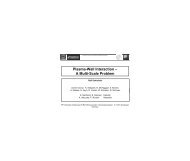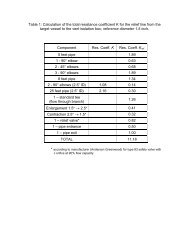Search for a Neutron Electric Dipole Moment at the SNS
Search for a Neutron Electric Dipole Moment at the SNS
Search for a Neutron Electric Dipole Moment at the SNS
Create successful ePaper yourself
Turn your PDF publications into a flip-book with our unique Google optimized e-Paper software.
Table 1: Summary of worldwide nEDM searches.Experiment UCN Source Cell Measurement σ dTechnique(10 −28 e·cm)CryoEDM (ILL) Superfluid 4 He 4 He Ramsey technique <strong>for</strong> ω Phase 1 ≈ 50External SQUID magnetometers Phase 2 < 5PNPI (ILL) ILL turbine Vacuum Ramsey technique <strong>for</strong> ω Phase 1 < 100PNPI/Solid D 2 E ⃗ = 0 cell <strong>for</strong> magnetometer Phase 2 < 10Crystal (ILL) Cold neutrons Solid Crystal Diffraction < 100PSI EDM Solid D 2 Vacuum Ramsey technique <strong>for</strong> ω Phase 1 ≈ 50External Cs and 3 He ⃗ magnetometers Phase 2 < 5Possible Hg or Xe comagnetometerMunich FRMII Solid D 2 Vacuum Under construction < 5Similar to PSI EDMnEDM (<strong>SNS</strong>) Superfluid 4 He 4 He 3 He capture <strong>for</strong> ω < 53 He comagnetometersquids & Dressed spinsTRIUMF Superfluid 4 He Vacuum Phase I RCNP < 10JPARC Solid D 2 Vacuum Under development < 5Crystal (NIST) Cold neutrons Solid Under development ≈ 5?Several unique fe<strong>at</strong>ures of <strong>the</strong> nEDM@<strong>SNS</strong> experiment include:• loading <strong>the</strong> neutron trap with UCNs th<strong>at</strong> are produced in 0.45 K liquid He via <strong>the</strong> phonon recoilprocess [6]• using superfluid 4 He as a working medium <strong>for</strong> <strong>the</strong> very high electric field• using a dilute mixture of polarized 3 He in superfluid 4 He as a co-magnetometer because <strong>the</strong> 3 He hasa negligible EDM• using a direct SQUID measurement of <strong>the</strong> precession frequency of <strong>the</strong> 3 He magnetic dipoles• using a superconducting shield to isol<strong>at</strong>e <strong>the</strong> measurement region from external magnetic field fluctu<strong>at</strong>ions• determining <strong>the</strong> difference in <strong>the</strong> neutron and 3 He precession frequencies from <strong>the</strong> spin-dependentabsorption cross section and <strong>the</strong> subsequent vari<strong>at</strong>ions in light intensity from scintill<strong>at</strong>ions in <strong>the</strong> 4 He• allowing two techniques <strong>for</strong> measuring <strong>the</strong> EDM, ei<strong>the</strong>r <strong>the</strong> direct method with SQUIDs or a dressedspinmethod th<strong>at</strong> uses a high-frequency magnetic field to modify <strong>the</strong> effective magnetic moments of<strong>the</strong> two polarized species [7]• providing a comparison measurement of changes in <strong>the</strong> precession frequency of <strong>the</strong> two species underE and/or B field reversal in two measurement cells• using <strong>the</strong> temper<strong>at</strong>ure dependence of <strong>the</strong> geometric phase <strong>for</strong> <strong>the</strong> 3 He to measure this importantsystem<strong>at</strong>ic [8, 9].Control of system<strong>at</strong>ic errors is essential <strong>for</strong> an experiment <strong>at</strong> <strong>the</strong> 10 −28 e·cm level. The differentteams have chosen different approaches, but <strong>the</strong> nEDM@<strong>SNS</strong> experiment has <strong>the</strong> most extensive program<strong>for</strong> estim<strong>at</strong>ing system<strong>at</strong>ic errors. A list of techniques incorpor<strong>at</strong>ed into <strong>the</strong> designs of <strong>the</strong> experimentalapproaches is shown in Table 2.The experiment represents a major technical challenge and requires a team with broad technical knowledgeand extensive experience. The collabor<strong>at</strong>ion, including researchers from twenty-one institutions with2



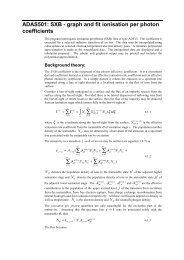
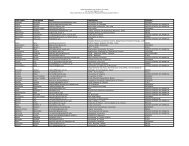
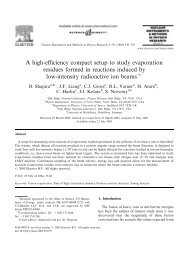
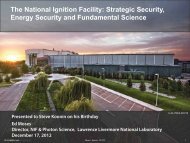

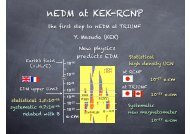
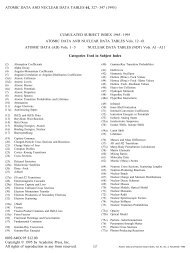


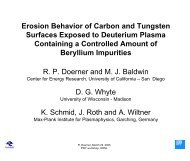
![Mixed-mode Calculations within the Nuclear Shell Model [pdf]](https://img.yumpu.com/28265410/1/190x146/mixed-mode-calculations-within-the-nuclear-shell-model-pdf.jpg?quality=85)
